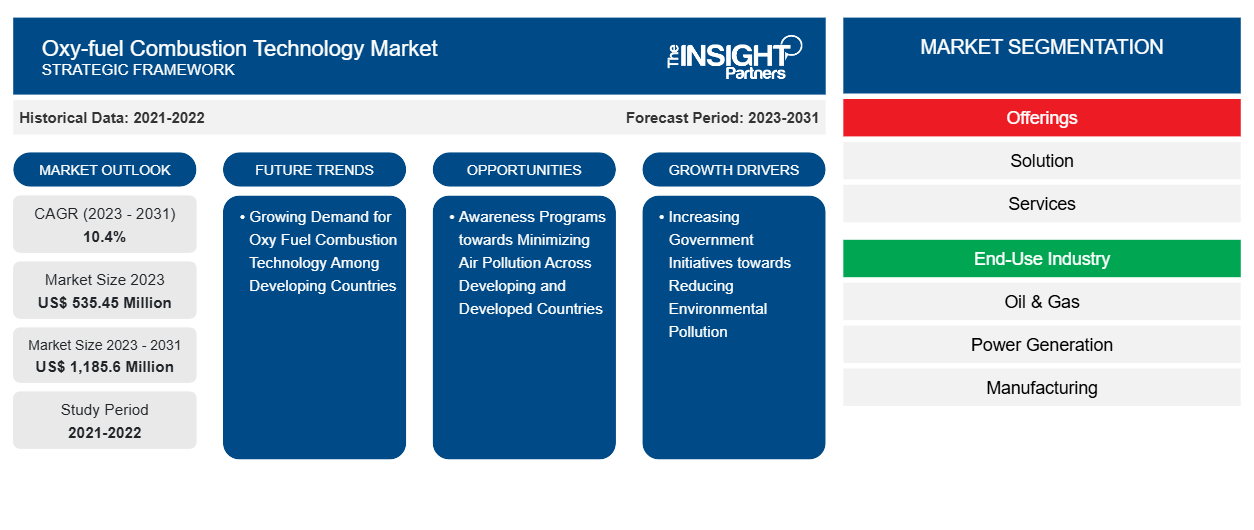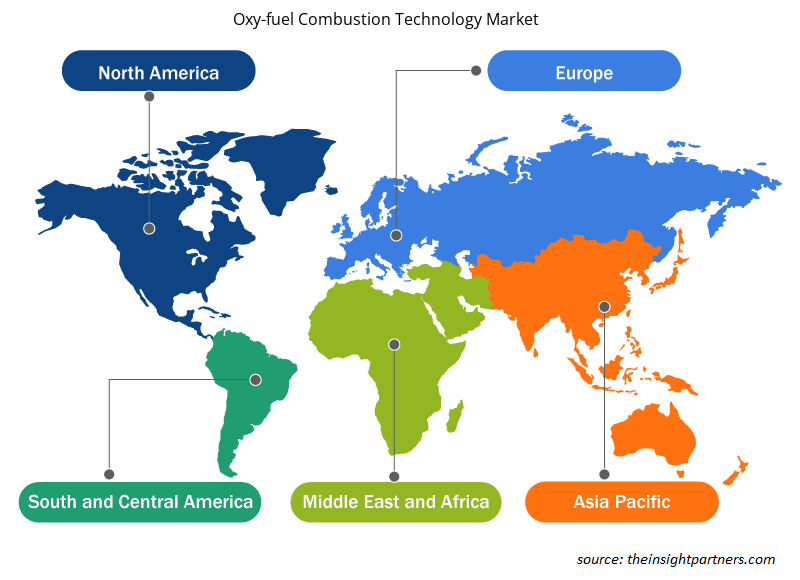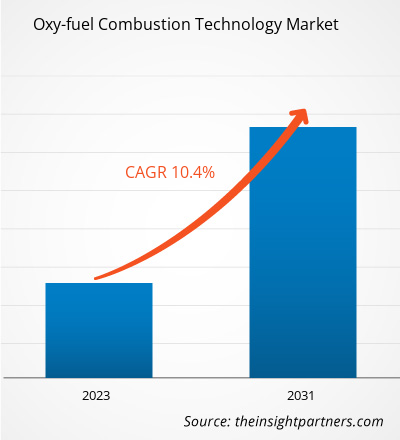The oxy-fuel combustion technology market size is projected to reach US$ 1,185.6 million by 2031 from US$ 535.45 million in 2023. The market is expected to register a CAGR of 10.4% in 2023–2031. Raising awareness towards reducing environmental pollution rise in demand for oxy-fuel combustion technology from oil & gas, manufacturing, glass, and thermal engineering industries are among the key factors driving the oxy-fuel combustion technology market.
Oxy-fuel Combustion Technology Market Analysis
The oxy-fuel combustion technology market is expected to experience considerable growth during the analyzed timeframe owing to the increasing demand for oxy-fuel combustion technology in developing countries to reduce air pollution and industrial gas emissions. In addition, several initiatives have been taken by local and federal government bodies across the world over the years to minimize hazardous industrial air disposal. For instance, in September 2022, the government of India also announced that they had set a new aim of a 40% reduction in particulate matter (PM) concentration in cities covered under NCAP by 2026, updating their earlier goal of 20 to 30% reduction by 2024. Such government initiatives across the globe are anticipated to drive market growth from 2023 to 2031.
Oxy-fuel Combustion Technology Market Overview
With the mounting population and industrialization, the demand for energy is also rising at the global level. The rise in energy consumption also boosted the need for minimized carbon dioxide emissions. This has resulted in driving the demand for oxy-fuel combustion technology across the globe. Oxy-fuel combustion is one of the most important technologies for capturing carbon dioxide in power plants. As a result, the adoption of this technology has increased, which is propelling the oxyfuel combustion technology market. Also, governments of several countries across the globe are taking various initiatives to reduce air pollution, which is further driving the growth of the market. Further, various industries are adopting the technology to reduce gas emissions, boosting the growth of the oxy-fuel combustion technology market. However, 02 supply and CO2 capture result in substantial energy penalties that must be mitigated through system optimization and the development of innovative processes; this poses one of the major challenges for market growth.
Customize This Report To Suit Your Requirement
You will get customization on any report - free of charge - including parts of this report, or country-level analysis, Excel Data pack, as well as avail great offers and discounts for start-ups & universities
Oxy-fuel Combustion Technology Market: Strategic Insights

- Get Top Key Market Trends of this report.This FREE sample will include data analysis, ranging from market trends to estimates and forecasts.
You will get customization on any report - free of charge - including parts of this report, or country-level analysis, Excel Data pack, as well as avail great offers and discounts for start-ups & universities
Oxy-fuel Combustion Technology Market: Strategic Insights

- Get Top Key Market Trends of this report.This FREE sample will include data analysis, ranging from market trends to estimates and forecasts.
Oxy-fuel Combustion Technology Market Drivers and Opportunities
Increasing demand for Oxy-fuel Combustion Technology in Developing Economies is expected to be the Prime Driver for the Oxy-fuel Combustion Technology Market.
The rising air pollution rate across India, China, Mexico, Malaysia, Russia, South Africa, and other developing countries is influencing the governments and industries across these countries to take initiatives to reduce the same to build a healthy environment for its population. According to the World Bank, nearly 33,000 deaths are recorded in Mexico each year due to air pollution. Industrial air pollution is responsible for nearly 20,000 of these deaths, which occur primarily in towns and cities. In Mexico, air pollution is a serious problem, accounting for nearly one-fifth of all deaths (5.9%).
World Health Organization (WHO) set a limit of 10 micrograms (thousandth of a gram) of PM2.5 per cubic meter of air (10g/m3) for average outdoor ambient air pollution. In Mexico City, however, average concentrations are around 25 g/m. In addition, in 2019, India recorded around 1.67 million deaths due to air pollution, which is 18% of the total deaths in the country. Thus, to minimize the PM-2.5 and other industrial gas emissions to reduce their environmental effects and impact on human health, the demand for oxy-fuel combustion technology is expected to increase during the forecast period.
Awareness Programs Towards Minimizing Air Pollution Across Developing and Developed Countries
Air pollution awareness programs or initiatives in developed and developing economies have grown over the years to combat the increasing climatic changes due to the increasing greenhouse gas emissions. WHO, the United States Environmental Protection Agency (EPA), and The World Economic Forum are among the international government entities working on the awareness programs. Similarly, various non-profit private organizations are taking initiatives to educate industries regarding the adverse effects of harmful or toxic gases emitted by them in the environment. These organizations include The Climate & Clean Air Coalition (CCAC), The Union of Concerned Scientists, and Earthjustice. A few awareness programs are listed below:
- BreatheLife, a global campaign, is aimed at encouraging people to act on air pollution or environmental pollution to protect human lives and the planet. This campaign is led by the WHO, the UN Environment Programme (UNEP), and the CCAC.
- The United Nations (UN) General Assembly designated the International Day of Clean Air for blue and clear skies. It was held in September 2022 to brought attention to various air pollutants affecting human and environmental health.
- Union Ministry of Environment for Forest and Climate Change, India organizes Swachh Vayu Diwas to raise awareness to improve air quality under the National Clean Air Programme (NCAP).
Thus, the growing initiatives by various organizations or entities are influencing the end-use industries for adopting technologies that will minimize the emission of hazardous gas into the environment, which is expected to boost the growth of the global oxy-fuel combustion technology market in the coming years.
Oxy-fuel Combustion Technology Market Report Segmentation Analysis
Key segments that contributed to the derivation of the oxy-fuel combustion technology market analysis are offerings and the end-use industry.
- Based on offerings, the oxy-fuel combustion technology market has been divided into solutions and services. The solution segment accounted for a larger market share in 2023.
- Based on the end-use industry, the oxy-fuel combustion technology market has been divided into oil & gas, power generation, manufacturing, metal & mining, and others. The power generation segment held a larger market share in 2023.
Oxy-fuel Combustion Technology Market Share Analysis by Geography
The geographic scope of the oxy-fuel combustion technology market report is mainly divided into five regions: North America, Europe, Asia Pacific, Middle East and Africa, and South America.
North America will dominate the oxy-fuel combustion technology market in 2023. The North America region includes the US, Canada, and Mexico. The US and Canada are highly dependent on fossil fuels to fulfill their primary energy demand. Hence, the emission of harmful gases in these countries is high. The largest resource of greenhouse gas emissions in the US is human activities that include burning fossil fuels for electricity, heat, and transportation. As per the United States Environmental Protection Agency (US EPA), in 2022, the total greenhouse gas emission in the US was 6,343.2 million metric tons of CO2 equivalent. Different economic sectors responsible for greenhouse gas emissions are transportation, holding 28% of greenhouse gas emissions in 2022; electricity production, accounting for 25%; industry, accounting for 23%; commercial and residential sectors holding 13%; and agriculture, accounting for 10%. Thus, the rapid growth in the above sectors will increase the harmful gas emissions in North America during the forecast period, which in turn is expected to raise the demand for oxy-fuel combustion technology in the future.
Oxy-fuel Combustion Technology Market Regional Insights
The regional trends and factors influencing the Oxy-fuel Combustion Technology Market throughout the forecast period have been thoroughly explained by the analysts at Insight Partners. This section also discusses Oxy-fuel Combustion Technology Market segments and geography across North America, Europe, Asia Pacific, Middle East and Africa, and South and Central America.

- Get the Regional Specific Data for Oxy-fuel Combustion Technology Market
Oxy-fuel Combustion Technology Market Report Scope
| Report Attribute | Details |
|---|---|
| Market size in 2023 | US$ 535.45 Million |
| Market Size by 2031 | US$ 1,185.6 Million |
| Global CAGR (2023 - 2031) | 10.4% |
| Historical Data | 2021-2022 |
| Forecast period | 2023-2031 |
| Segments Covered |
By Offerings
|
| Regions and Countries Covered | North America
|
| Market leaders and key company profiles |
Oxy-fuel Combustion Technology Market Players Density: Understanding Its Impact on Business Dynamics
The Oxy-fuel Combustion Technology Market is growing rapidly, driven by increasing end-user demand due to factors such as evolving consumer preferences, technological advancements, and greater awareness of the product's benefits. As demand rises, businesses are expanding their offerings, innovating to meet consumer needs, and capitalizing on emerging trends, which further fuels market growth.
Market players density refers to the distribution of firms or companies operating within a particular market or industry. It indicates how many competitors (market players) are present in a given market space relative to its size or total market value.
Major Companies operating in the Oxy-fuel Combustion Technology Market are:
- Falorni Gianfrance SRL
- General Electric Co
- HeidelbergCement AG
- Hitachi Ltd
- Jupiter Oxygen Corp
- Linde Plc
Disclaimer: The companies listed above are not ranked in any particular order.

- Get the Oxy-fuel Combustion Technology Market top key players overview
Oxy-fuel Combustion Technology Market News and Recent Developments
The oxy-fuel combustion technology market is evaluated by gathering qualitative and quantitative data post primary and secondary research, which includes important corporate publications, association data, and databases. The following is a list of developments in the market for oxy-fuel combustion technology market and strategies:
- In November 2022, HeidelbergCement started the further development and scaling-up of the LEILAC technology together with Calyx, an Australian technology company and a European consortium. With this strategic initiative, the company is scaling up the time and money it spends on making the cement production process more sustainable by utilizing carbon capture technology.
- In October 2022, SLB and Linde collaborated on carbon capture, utilization, & sequestration (CCUS) projects to enhanced decarbonization solutions across various industrial and power sectors. The collaboration was aimed at combining decades of experience in carbon dioxide (CO2) capture & sequestration, innovative or advanced technology portfolios, project development & execution expertise, and engineering, procurement, & construction (EPC) capabilities.
Oxy-fuel Combustion Technology Market Report Coverage and Deliverables
The “Oxy-fuel Combustion Technology Market Size and Forecast (2021–2031)” report provides a detailed analysis of the market covering below areas:
- Market size and forecast at global, regional, & country levels for all the key market segments covered under the scope
- Market dynamics such as drivers, restraints, and key opportunities
- Key future trends
- Detailed Porter’s Five Forces analysis
- Global and regional market analysis covering key market trends, major players, regulations, and recent market developments
- Industry landscape and competition analysis covering market concentration, heat map analysis, prominent players, and recent developments
- Detailed company profiles with SWOT analysis
- Historical Analysis (2 Years), Base Year, Forecast (7 Years) with CAGR
- PEST and SWOT Analysis
- Market Size Value / Volume - Global, Regional, Country
- Industry and Competitive Landscape
- Excel Dataset
- Oil and Gas Fishing Market
- Wireline Services Market
- Oil Country Tubular Goods Market
- Europe, MENA, North America Portable Integrated Photovoltaic Market
- Forklift Battery Market
- Transcritical CO2 Market
- Gas Engine Market
- District Heating Market
- Managed Pressure Drilling Market
- Geothermal Power Generation Market
Testimonials
I wish to appreciate your support and the professionalism you displayed in the course of attending to my request for information regarding to infectious disease IVD market in Nigeria. I appreciate your patience, your guidance, and the fact that you were willing to offer a discount, which eventually made it possible for us to close a deal. I look forward to engaging The Insight Partners in the future, all thanks to the impression you have created in me as a result of this first encounter.
DR CHIJIOKE ONYIA, MANAGING DIRECTOR, PineCrest Healthcare Ltd.The Insight Partners delivered insightful, well-structured market research with strong domain expertise. Their team was professional and responsive throughout. The user-friendly website made accessing industry reports seamless. We highly recommend them for reliable, high-quality research services
Yukihiko Adachi CEO, Deep Blue, LLC.Reason to Buy
- Informed Decision-Making
- Understanding Market Dynamics
- Competitive Analysis
- Customer Insights
- Market Forecasts
- Risk Mitigation
- Strategic Planning
- Investment Justification
- Identifying Emerging Markets
- Enhancing Marketing Strategies
- Boosting Operational Efficiency
- Tracking Industry Innovations
- Aligning with Regulatory Trends
Yes! We provide a free sample of the report, which includes Report Scope (Table of Contents), report structure, and selected insights to help you assess the value of the full report. Please click on the "Download Sample" button or contact us to receive your copy.
Absolutely — analyst assistance is part of the package. You can connect with our analyst post-purchase to clarify report insights, methodology or discuss how the findings apply to your business needs.
Once your order is successfully placed, you will receive a confirmation email along with your invoice.
• For published reports: You’ll receive access to the report within 4–6 working hours via a secured email sent to your email.
• For upcoming reports: Your order will be recorded as a pre-booking. Our team will share the estimated release date and keep you informed of any updates. As soon as the report is published, it will be delivered to your registered email.
We offer customization options to align the report with your specific objectives. Whether you need deeper insights into a particular region, industry segment, competitor analysis, or data cut, our research team can tailor the report accordingly. Please share your requirements with us, and we’ll be happy to provide a customized proposal or scope.
The report is available in either PDF format or as an Excel dataset, depending on the license you choose.
The PDF version provides the full analysis and visuals in a ready-to-read format. The Excel dataset includes all underlying data tables for easy manipulation and further analysis.
Please review the license options at checkout or contact us to confirm which formats are included with your purchase.
Our payment process is fully secure and PCI-DSS compliant.
We use trusted and encrypted payment gateways to ensure that all transactions are protected with industry-standard SSL encryption. Your payment details are never stored on our servers and are handled securely by certified third-party processors.
You can make your purchase with confidence, knowing your personal and financial information is safe with us.
Yes, we do offer special pricing for bulk purchases.
If you're interested in purchasing multiple reports, we’re happy to provide a customized bundle offer or volume-based discount tailored to your needs. Please contact our sales team with the list of reports you’re considering, and we’ll share a personalized quote.
Yes, absolutely.
Our team is available to help you make an informed decision. Whether you have questions about the report’s scope, methodology, customization options, or which license suits you best, we’re here to assist. Please reach out to us at sales@theinsightpartners.com, and one of our representatives will get in touch promptly.
Yes, a billing invoice will be automatically generated and sent to your registered email upon successful completion of your purchase.
If you need the invoice in a specific format or require additional details (such as company name, GST, or VAT information), feel free to contact us, and we’ll be happy to assist.
Yes, certainly.
If you encounter any difficulties accessing or receiving your report, our support team is ready to assist you. Simply reach out to us via email or live chat with your order information, and we’ll ensure the issue is resolved quickly so you can access your report without interruption.





















 Get Free Sample For
Get Free Sample For